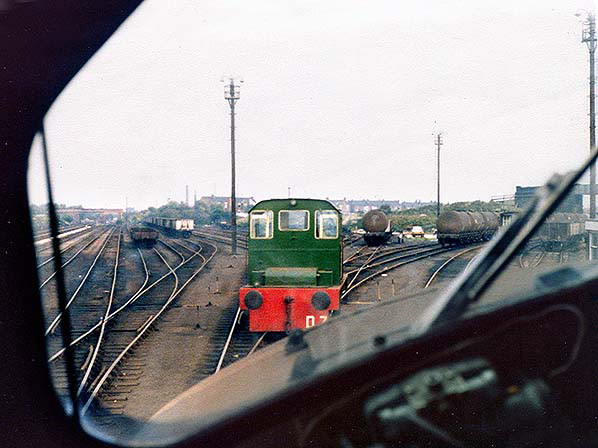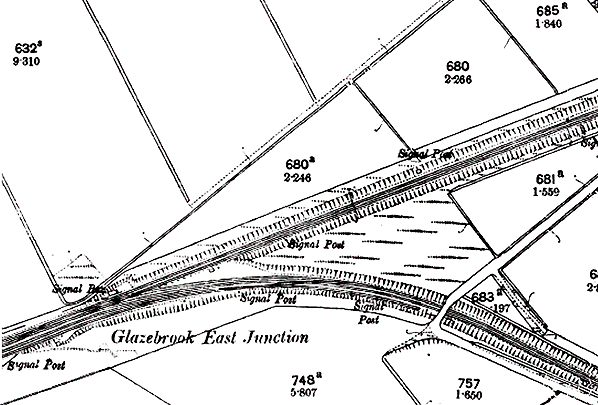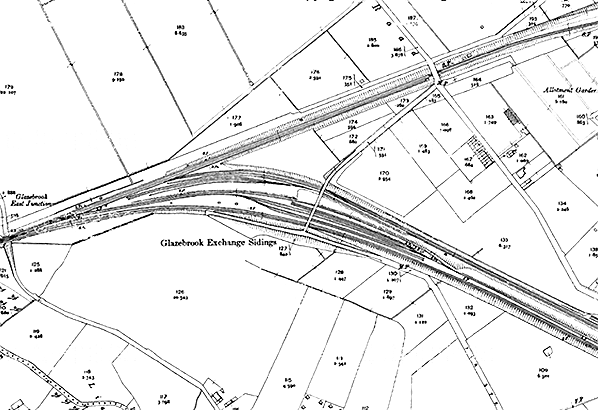Glazebrook East Junction was located on the Cheshire Lines Committee (CLC) Liverpool and Manchester railway and was the point at which a line to Godley diverged. The CLC was joint company with three partners, the Great Northern Railway (GNR), the Manchester Sheffield & Lincolnshire Railway (After 1897 the Great Central Railway - GCR), the Midland Railway (MR). All three of the partner companies had wanted to gain independent access to Liverpool and it was for this reason that the Liverpool and Manchester line was opened.
At Glazebrook it was the line from Skelton West Junction (which was on the existing CLC Godley to Altrincham line opened as a through route by February 1866) to Cressingham Junction (near Liverpool) that opened first to goods services on 1 March 1873. On 1 August 1873 passenger services began operating along the route. On 2 September 1873 the line from Glazebrook East Junction to Manchester opened to all traffic creating the junction at Glazebrook.

Glazebrook East sidings looking east in the late 1970s seen from the cab of English Electric class 40 locomotive number 40 025. The green locomotive was Manchester Ship Canal locomotive number 7. It had just brought tank wagons to Glazebrook East sidings from the Glazebrook oil terminal. The class 40 would haul the tanks away from Glazebrook.
Photo
by Arnie Furniss from his Deadmans Handle Flickr photostream
To control the Glazebrook East Junction a signal box was provided on the 'up' side (Manchester direction) side of the main line close to the Junction. The box opened on 27 June 1873 and was originally named Glazebrook Junction. The box was renamed Glazebrook East Junction in May 1879 when a new line opened to the west of Glazebrook forming a junction (Glazebrook West Junction) that also needed a signal box.
Although a busy junction Glazebrook East had a fairly basic layout for the first twenty years of its existence with the two double track railways converging. In 1893 the layout changed dramatically. The construction of the Manchester Ship Canal a mile to the south of Glazebrook made the construction of a deviation line for the Skelton Junction route necessary so that 75ft clearance could be achieved between the line and the canal. The deviation line was built to the west of the original line and a new junction with the Liverpool and Manchester route was created also to the west of the original forming a double junction at Glazebrook East. The new line opened for goods services on 27 February 1893 and for passengers on 1 August 1893. The original signal box closed in February 1893 and was replaced by a CLC type CL1a box with a 32 lever frame.
In August 1893 the original Skelton Junction line closed as a through route between Glazebrook and Partington and it was severed when the canal was dug through it at Cadishead. On both sides of the canal it was retained as a link to the canal on which coal loading facilities were developed called the 'Partington Coal Basin'. Over the years other industries grew up along the banks of the canal and the original CLC line provided a connection to them.
At Glazebrook East Junction an area of sidings was developed in the fork of the junction to handle the exchange of goods wagons between the main line and the coal basin. The sidings were initially located between the old and new Skelton Junction routes but later the majority were located parallel to the Liverpool and Manchester line. The Manchester Ship Canal Company (MSC) had locomotives of its own that served its internal railway system. The MSC locomotives worked to Glazebrook East sidings with trains from the coal basin and other local industries.
 The location of the Glazebrook East Junction sidings
The location of the Glazebrook East Junction sidings

The original Junction at Glazebrook East seen on a 1890 map
In 1910 the Partington Steel and Iron Company opened a large steelworks at Irlam which was provided with a rail connection onto the original CLC line. This brought even more traffic to the Glazebrook East sidings. There were further extensions to the sidings in 1933 and in the early 1940s. Ground frame boxes were provided to control the sidings. Staff accommodation blocks were also erected at the site.
The sidings remained busy well into the second half of the 20th century. The Glazebrook East Junction signal box was replaced by a a British Railways London Midland Type 15 structure with 80 levers on 22 January 1961. The box took over from some of the frames that were located at the sidings.
In 1979 the Irlam Steelworks ceased production and on 3 July 1981 the Partington Coal Basin closed completely. The Skelton Junction line saw its last train on 29 July 1982 and it closed from Glazebrook East Junction to Partington Junction on 4 September 1983. Most of the sidings stood empty for most of the time and the majority were lifted by 1987.
The only rail served facility that remained by the 1980s was the British Tar Products (BTP) plant which had an unloading facility at the end of the original CLC route for oil trains. Block oil trains continued to use the facility until September 1999.
In 2012 a loop siding remained operational at Glazebrook East and a section of the original Skelton Junction line remained in situ, complete with a working signal, for a short distance. It was though very overgrown.

By 1907 there were a number of sidings at Glazebrook East Junction. Further sidings would be added in the following years.
Sources:
|

